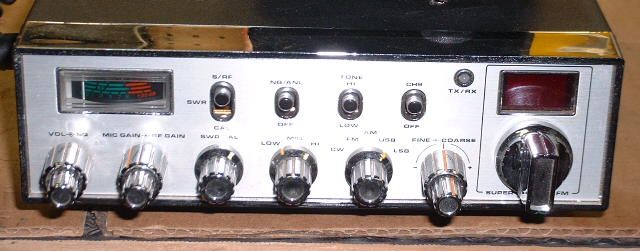

This is the SuperStar 360 which was another of the 1st generation of Uniden-made export radios to reach the U.S. shores in the early 1980's. Upon first examination, one can't help but recognize the visual similarity to the Cobra 148 GTL. Upon closer inspection though, you can see that there are a few additional features that the also Uniden-made Cobra 148 did not have. As an export radio, it was designed to be used in a CB market outside of the U.S., so it should come as no surprise to learn that these export radios were not legal for use in the U.S., The biggest features which set export radios apart from a similar domestic radio were additional channels, higher power output, and more modes. A user could buy an export radio for not much more than a standard domestic radio, and it already did the things than many people traditionally hacked up their standard radios to do. It's no wonder that these radios became popular (despite not being legal to sell in the U.S.) practically overnight.
The SuperStar 360 did not disappoint in the feature department. Besides the usual expected controls for Volume, Squelch, Channel Selector, it had, as an all-mode rig, AM/FM/CW/USB/LSB modes, both a coarse and fine Clarifier (The fine was receive-only). Additional features included a Mic Gain, R.F. Gain, built-in SWR function in addition to the standard S/RF meter, a Tone Hi/Lo switch, and a switchable ANL/NB. In the frequency department, there were 3 banks of channels (40 down, the regular 40, plus 40 up) for a total of 120 channels. It also included an instant channel 9 switch (On an Export radio???). The one really bad feature IMHO, was an "Always-on" Roger Beep.
Performance wise, this radio was similar to the domestic Cobra 148. Receiver sensitivity and noise floor were good, and adjacent channel rejection was fairly good. Like most other Uniden radios, the Noise Blanker did a superb job of suppressing pulse noise. The transmitter in this model was a "standard power" version, which would do about 20 watts on SSB, and about 5 watts on AM with good modulation.
You might think that a radio with this many features out of the box, would not be a good candidate for further modifications, but you would be wrong. This radio uses a Motorola MC145106 PLL chip which was capable of many more channels (511) than just the stock 120. Each channel band was programmed into a set of 14008 adder chips through a matrix of diodes and selected with the "Low/Mid/Hi" switch. It was a simple matter to add additional programming diodes, and then commandeer the Tone Hi/Low switch to use as a frequency range Hi/Low switch to feed the band switch which, when all said and done, yielded 6 bands of channels, similar to that found standard on the SuperStar 3900. The Channel 9 switch was a prime candidate to reassign as a +10Khz switch, which was unfortunately not included standard. The "always-on" Roger Beep could easily be defeated, or you could commandeer the ANL/NB switch to serve as an On/Off switch for the Roger Beep.
There were also mods which could be done to the transmitter. The PC board had a stuffing option for adding an additional R.F. final transistor, and associated support components. Adding this would jump the output power similarly to what other "dual final" export radios would do. However, I found that I had greater success by just changing out the stock final for a single MRF-477. This was back when that device was still in production and readily available. With some other modifications, power output could reach the 35 watt range on SSB, and could support close to an 8 watt carrier on AM. Note that I performed those power mods strictly to satisfy my own curiosity. The amount of signal gain was not that significant (3 db or less), and the higher power would overdrive an amplifier, so it's not something I'd recommend as a matter of course.
At one time, I owned 2 SS 360's. The first one, I modified for 6 band operation, and added a noise squelch circuit since the time period which I owned it was when I was spending a great deal of time using the FM mode, and running it mobile. A noise squelch works on signal/noise ratio, and not just signal level, and is much less prone to popping open on noise spikes or man-made noise sources. This greatly improved the receiver performance while using FM. My 2nd 360, I modified with the higher power final and a "reverse" roger beep (It sounded when first transmitting like a Browning ping). Both radios were eventually sold, the second one ending up in Art's hands.
On a scale of 1 to 10, I give this radio a 6. It was a fun radio to work on and modify. Its performance was good and it was reliable.